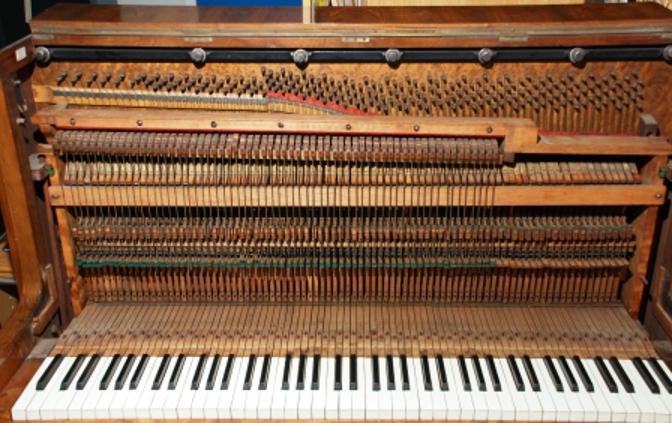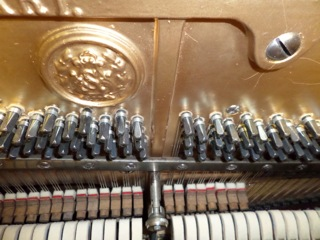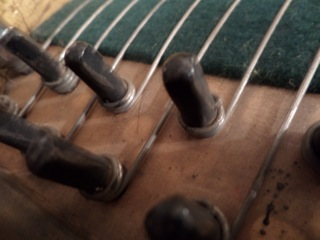Let’s talk about uprights for the moment. Avoid birdcage (over-damper) uprights if possible. If the first thing you see on opening the front is 65 vertical wires instead of the piano hammers, it’s a birdcage. Some are perfectly good but most are not and they don’t get in as good tune because access to the strings is so limited. Here’s one, courtesy of David Boyce Pianos .

- Look at a few pianos in your price range. You might fall for the first one but see as many as possible.
- Ask to remove the front panel. Undo the catches on either side inside the top of the front door, lift it off carefully so as not to nick anything or anyone. Ask permission to lean it against a wall out of the way.
- Inspect the tuning pins to see that they are all original (same fatness and colour) and all the coils where the strings attach are original and not missing any. You don’t want to see any replaced shiny ones nor any missing coils. Also check that the bottom of the coil is not flush up against the metal plate (or wooden pin block depending on the configuration). A scant 1/4″ minimum means nobody has tapped in the pin to combat a faulty pin block. You don’t want to have to spend £1500 on restringing.
- How are the hammers and shanks? You won’t easily see them in the case of birdcage pianos but try to peer inside there. You don’t want to see any replaced parts in there as with the tuning pins and strings. Check the top few hammers. Are they worn down to the wood? A bad sign!! Old hammers can be reshaped to restore the former glorious tone on most pianos unless there’s no felt left to shape (see my short video on hammer shaping http://tunerben.com/shape-piano-hammers/).
- Play a chromatic scale (hit each white and black key) from middle C down to the bottom. Are any horribly discordant? In other words have any the tuning pins slipped? A sign that you’ll have to treat the pin block (a couple of hundred ££ unless you can do it yourself, see my blog on loose tuning pins). Start in the middle again and go to the top note, same thing.
Play a song on the piano even if you can’t play at all. Improvise. Try the pedals. The piano’s probably horribly flat, but then again most pianos are neglected and tuning is only £55. But you’ll get a feel for the gestalt of the piano. Then call a tuner if possible while you’re at the piano and ask him to have a listen. If you like the piano then hire the tuner to check it out for you before you take the plunge. Moving will often cost more than the price of the piano so don’t start moving it about before you’re sure it’s a keeper.

